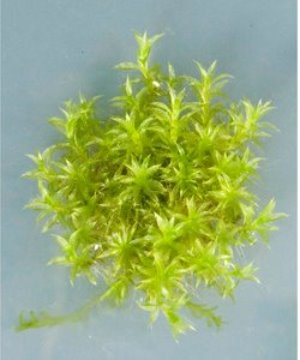Apr. 18, 2008 Research Highlight Biology
Landmark genome contains wealth of data
Moss provides clues as to how plants came ashore
 Figure 1: The moss Physcomitrella patens—about two centimeters in diameter.
Figure 1: The moss Physcomitrella patens—about two centimeters in diameter.
Molecular biologists from RIKEN’s Genomic Sciences Center and Plant Science Center in Yokohama are among 70 researchers from more than 40 institutes, including Japan’s National Institute for Basic Biology (NIBB), who recently published the draft genome of the moss, Physcomitrella patens 1. The genetic information contained in the draft will provide insight into the development of plants and their ability to survive on land, particularly their drought tolerance.
Physcomitrella, a small, delicate moss often found along the edges of lakes and rivers (Fig. 1), is a modern relative of the plants which first colonized land and a key evolutionary link between ancient aquatic single-celled algae and terrestrial flowering plants. The species has already become an important experimental organism, because its genetic material can be manipulated efficiently, it reproduces rapidly, and its simple structure allows it to be observed and imaged easily. The ability to study drought tolerance and the synthesis of plant walls in Physcomitrella should increase the capacity to groom crops against water shortages and lead to more effective ways of decomposing cellulose in biofuels.
It is clear from the draft, the researchers say, that Physcomitrella underwent at least one large-scale duplication of its genome, possibly more. Such genetic upheavals are evolutionarily important, because copies of genes can subsequently be modified while the organism retains the originals with all the information to form a viable individual.
The mosses are bryophytes, plants which require access to water to reproduce sexually, and which branched off the line leading to flowering plants about 400 million years ago. Hence, by comparing the moss genome to those of three well-known unicellular green algae and three flowering plants, the researchers have already begun to identify broad genetic trends in the evolution of characteristics which allowed plants to survive on land.
They have concluded that among the genes associated with terrestrial survival there are genes for the development of systems for transporting water and for signaling systems that coordinate growth and the response to dehydration. The genes associated with terrestrial survival were gained by the last common ancestor of all land plants.
The mosses also evolved elaborate DNA repair mechanisms to combat the greater impact of radiation on land.
Mitsuyasu Hasebe and colleagues at the NIBB have made a major contribution to all phases of the genomic study. The RIKEN researchers helped determine end sequences of DNA segments used to puzzle out the genome, says contributor Atsushi Toyoda. “We will continue to work at completing and verifying the genome sequence and identifying functional genes,” he says.
References
- 1. Rensing, S.A., Lang, D., Zimmer, A.D., Terry, A., Salamov, A., Shapiro, H., Nishiyama, T., Perroud P-F., Lindquist, E.A., Kamisugi Y., et al. The Physcomitrella genome reveals evolutionary insights into the conquest of land by plants. Science 319, 64–69 (2007). doi: 10.1126/science.1150646
